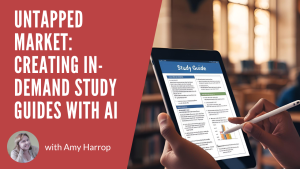 Who doesn’t need some help studying? Students at every age, from elementary school through graduate school, may seek out study guides to help them grasp important concepts or pass tests. And you can be the one to provide them with exactly what they need to accomplish these goals.
Who doesn’t need some help studying? Students at every age, from elementary school through graduate school, may seek out study guides to help them grasp important concepts or pass tests. And you can be the one to provide them with exactly what they need to accomplish these goals.
Creating a study guide might seem like a huge task, but it doesn’t have to be if you use AI tools. There are so many cool software options and digital tools available now that you can take what used to be a long and drawn-out process and create a full study guide in just a few hours. Here’s what you need to know.
What is a Study Guide?
 We’ll start with the basics. A study guide is typically a collection of items designed to help a student learn about a topic or prepare for a test. Study guides may be used by students of any age from elementary school through graduate school and may be organized for any purpose.
We’ll start with the basics. A study guide is typically a collection of items designed to help a student learn about a topic or prepare for a test. Study guides may be used by students of any age from elementary school through graduate school and may be organized for any purpose.
To give you an idea of how many potential types of study guides you can create, here are some of the most popular categories and topics found in study guides.
Subject Study Guides
 Subject study guides could be about almost any topic or school subject you can imagine. Here are some examples.
Subject study guides could be about almost any topic or school subject you can imagine. Here are some examples.
- English Language Arts: Grammar, Punctuation, Vocabulary, Writing Tips, Literature, Poetry, Themes, etc.
- Mathematics: Basic Math (Addition, Subtraction, Multiplication, Division), Fractions, Word Problems, Pre-Algebra, Algebra, Geometry, Trigonometry, Pre-Calc, Calculus, etc.
- Science: Ecology, Geology, Biology, Chemistry, Physics, Anatomy, etc.
- History: History by Country/Region (US, UK, Sub-Saharan Africa) or by Era (Victorian England, WWII Germany, Revolutionary War US, etc.)
- Social Sciences: Economics, Sociology, Anthropology, etc.
- Foreign Languages: Spanish, French, Japanese, German, Chinese, ASL, etc.
You get the idea. Any subject that a student at any age might be learning about in school could be made into a study guide.
Test Study Guides
Another common type of study guide that’s available is the study guide that’s designed to help students prepare for and ace a specific test. Here are a few examples.

- Scholastic Aptitude Test (SAT) preparation
- ACT prep (achievement tests by topic)
- AP test prep (advanced placement tests by topic)
- LSAT prep (law school admission test)
- MCAT prep (medical school admission test)
- GMAT prep (business school admission test)
- US citizenship test
- Real estate exams and other professional certifications
If you go this route, our recommendation is to break down each test into sections, explain how each works, provide test-taking tips, and provide full-length practice tests, which you can find online.
Graduate School Study Guides
 A quick glance at Etsy reveals that there are a ton of study guides to help people through graduate school. Here are some of the most popular.
A quick glance at Etsy reveals that there are a ton of study guides to help people through graduate school. Here are some of the most popular.
- Nursing school guides
- Medical school guides
- Law school guides
- Business school guides
For this type of guide, you’ll need to cover a variety of subjects. For example, a nursing school guide might include subjects like anatomy, OB/Gyn, medical/surgical, and pharmacology.
Learning Challenges Study Guides
Finally, you may want to consider study guides designed specifically for students who experience learning challenges.

Here are a few examples:
- ADHD
- Dyslexia
- Auditory processing disorder
This type of study guide should focus less on specific topics and more on studying techniques, time management, and other related issues.
AI Tools to Use for Study Guides
 There are many AI tools you can use to create study guides quickly. We’re just going to list a few favorites to get you started.
There are many AI tools you can use to create study guides quickly. We’re just going to list a few favorites to get you started.
- Canva is our favorite design tool overall. Their Magic Studio includes several AI tools, including Magic Design and Magic Write, which can help you streamline content creation for study guides. The Pro plan costs just $12.99 per month.
- Scribe has an AI tool that’s designed specifically to create study guides. It’s free and you can get started with it immediately from your browser or tablet.
- Atlas allows you to upload existing study materials (from textbooks or worksheets, for example) and turn them into custom study guides.
- ChatGPT is a great resource for quickly drafting content, including pop quiz questions and review sheets.
- Our AI Study Guide Bot Builder will do everything for you—and you can get it with our new , product, AI Study Guide Publishing Bonanza, which I’ll link at the end of this article.
These are just a few of the tools that we’ve found useful. You may need to experiment a bit to figure out which tools you prefer. Our recommendation would be to start with free tools or free trials. That way you can play around without spending any money at first.
Items to Include in Your Study Guide
 Before we get into some of our best tips for creating unique study guides, here are some of the items you may want to include.
Before we get into some of our best tips for creating unique study guides, here are some of the items you may want to include.
- Flash cards for vocabulary and key concepts
- Worksheets
- Topic-specific overviews
- Diagrams
- Study calendars
- Stickers
- Sample questions
- Quizzes
- Full practice tests
- Studying tips and hacks
Get creative and make sure to think about what will help students the most. Study guides are most likely to be appealing if they include an array of individual products bundled together. They offer a lot of value!
Tips for Creating Study Guides with AI
To close out, here are some of our best tips for creating study guides with AI.

- Choose a topic you have some familiarity with for your first guide. You can branch out, but the creation process will be easier and more intuitive if you understand the topic or test being covered.
- Research other study guides that are available. We like to use Etsy as a research tool. You can make notes about what’s there and what’s not and look for ways to differentiateyour guide from the others out there.
- To save time, we also recommend noting the keywords and hashtags used in the product descriptions of the guides you research.
- Use AI tools to streamline content creation. For example, you might use a writing tool to generate practice questions and then a drag-and-drop design tool to create the layout of the page and add design elements.
- Decide whether to sell your guide as a printed product or a digital download. Many people prefer digital options because they tend to have lower prices and they’re available immediately. You could do both!
Make sure to carefully proofread and edit your guide. If grammar, spelling, and punctuation aren’t your strong suits, then using a tool like Grammarly can help.
Creating study guides is easy once you get the hang of it, and using AI tools can make it even faster.
If you want some help creating study guides, check out AI Study Guide Publishing Bonanza! It comes with our AI Study Guide Bot Builder, tons of over-the-shoulder videos, and our best tips and tricks for creating study guides that sell.



